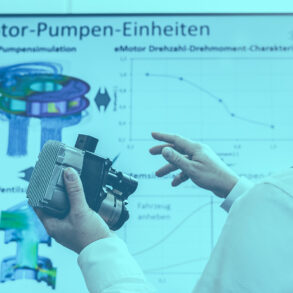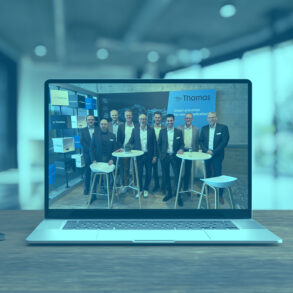Technologies are growing increasingly complex and innovation cycles ever shorter. Anyone who wants to offer their customers solutions to specific problems of tomorrow needs to think both ahead and, in particular, outside the box. Just like the Advanced Engineering team at Thomas.
There is no doubt about it: The self-adapting electrohydraulic actuator (EHA) marks a real milestone in the history of Thomas products. Rather than resulting from a customer’s request, however, the idea for automatic start-up was born in the technology lab in Dresden. The controller that is used was also invented in the capital of Saxony.
Thomas has had a technology lab at its Dresden site since as long ago as 2015. It was here that the Advanced Engineering team was set up in 2018. Together with CTO Jürgen Heck, it is responsible for evolving and breathing life into the company’s very own technology roadmap. The team consists of three colleagues from Mechatronics, Electrical Engineering, and Mechanical Engineering, who think and work across disciplinary boundaries, analyze current trends, and pre-empt future needs. Many of the issues that they tackle come straight from Development, while others are their own additions to the agenda.
Dresden is a leading technology and innovation cluster
Catalyst for technical evolution
A broad technical understanding of each individual is the basis of the team’s success in the technology lab. Every day, the focus is on different topics – on one day RFID technology, on another sensors or valves and on another the production of plastics, with acoustics or with software development. This mix of topics is challenging on the one hand, and very exciting on the other. Your own work must always be questioned independently and in the whole team. This is the only way that it will continue to be an important source of inspiration for the further technical development of Thomas.
In fact, the question of what can be done better and how is precisely the one that has sparked innovations since the very beginning. In Predevelopment, therefore, product knowledge goes hand in hand with creativity and embracing new things. And the facility in Dresden is the perfect place for this, because the city is a leading technology and innovation cluster with numerous start-ups and a technical university that is one of the best in Germany, TU Dresden. This environment is ideal for free and effective networking – also because the fair distance to the company headquarters enables a decoupling from day-to-day business and thus valuable freedom for basic work.
Predevelopment saves time and money
Many innovative companies have a predevelopment department – not to burnish their image, but rather to improve their business performance. An efficient predevelopment operation reduces the risk of investing time and money into something that ultimately does not work. Against the background of increasingly complex, interdependent systems, this preparatory work is an important factor in facing the growing pressure to innovate competently and confidently. Something, like Thomas’s “Sense. Think. Act.” strategy, for instance, would be virtually inconceivable without predevelopment – after all, smart products require features that have not been focussed on until now.
One idea. Four phases.
Every predevelopment project goes through the same four phases: planning, design, implementation, and transfer. During the first three, the team performs groundwork and liaises closely with the Service Units and Customer Units. Finally, in the transfer phase, the results of this process are passed on to Product Development.
In an ideal scenario, the results will indicate where challenges are likely and how feasible the idea is from a technical perspective. This is done in an extremely tangible way with the aid of “demonstrators” – fully functioning prototypes or functional models such as 3D printouts or software modules. The Predevelopment team often collaborates with TU Dresden to produce these, particularly where experimental fields are involved. The findings can then be incorporated into the work being done by Thomas Project and Product Management, thus improving resource planning and getting products ready for series production more quickly.
A good example of this process is the Thomas Electronic Standard, which, as a modular system, will play a critical role in products and systems of the future, among other things.











